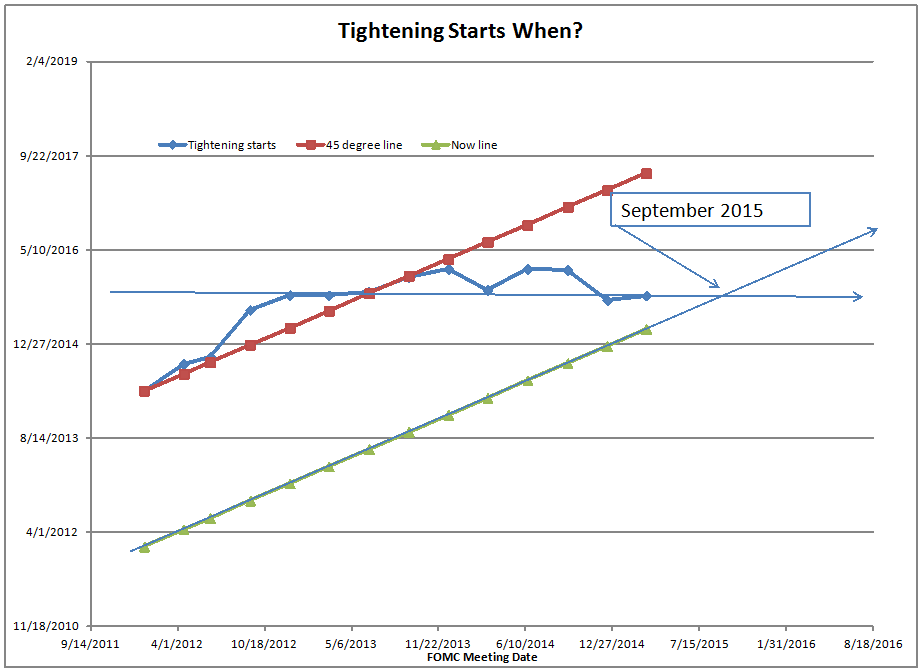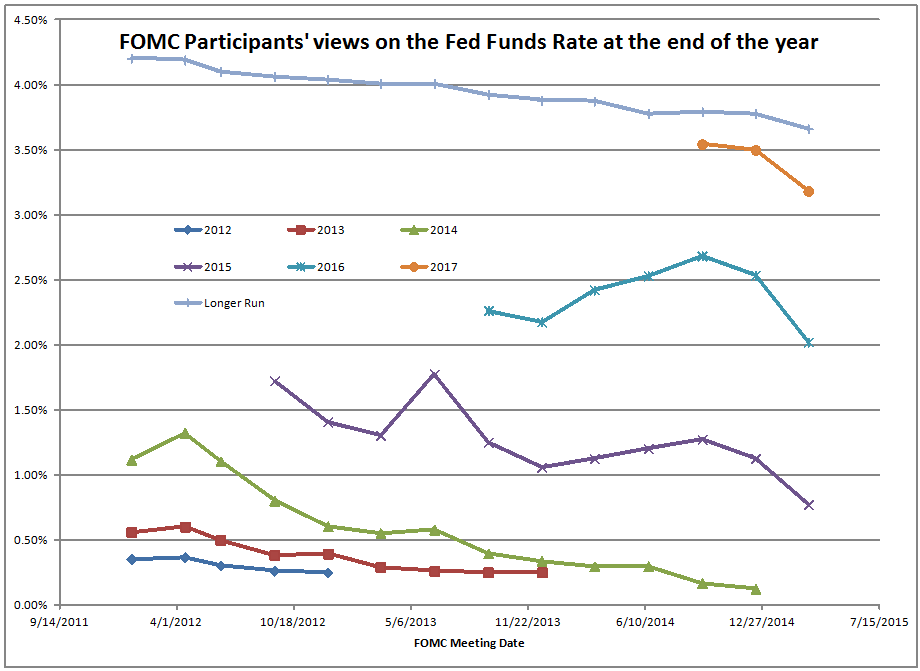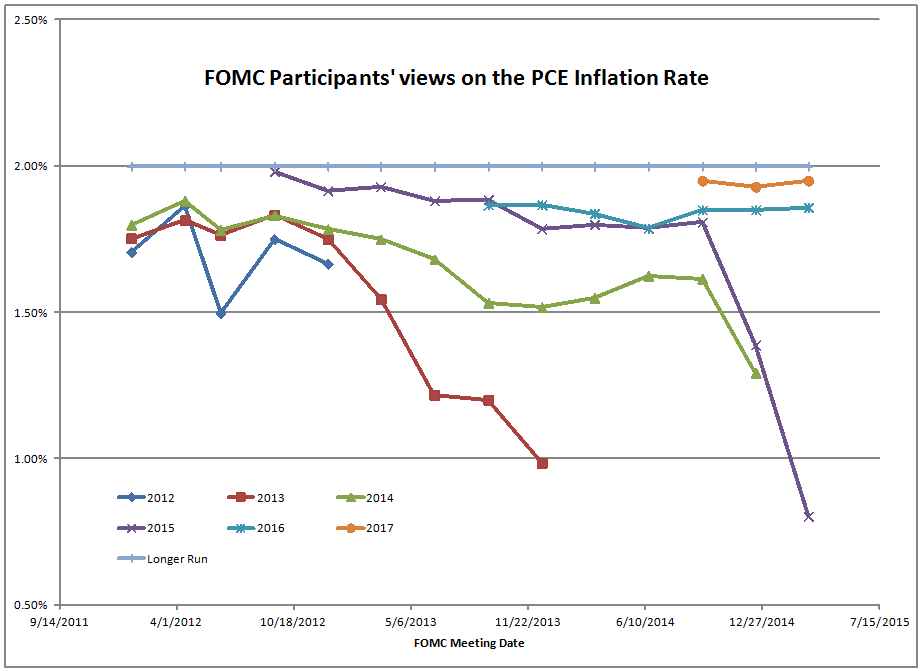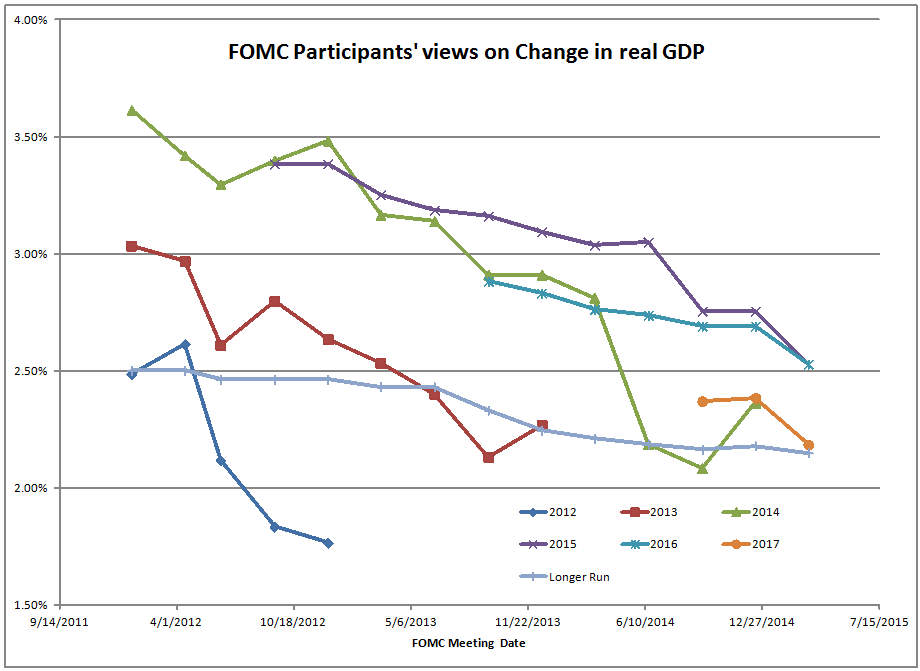
There was a lot of hoopla yesterday over the FOMC removing the word “patient” from its statement. ?But when you read the sentence that replaced the sentence containing the word patient, you shouldn’t think that much has changed:
Consistent with its previous statement, the Committee judges that an increase in the target range for the federal funds rate remains unlikely at the April FOMC meeting. The Committee anticipates that it will be appropriate to raise the target range for the federal funds rate when it has seen further improvement in the labor market and is reasonably confident that inflation will move back to its 2 percent objective over the medium term. This change in the forward guidance does not indicate that the Committee has decided on the timing of the initial increase in the target range.
There are two contingencies here, which are both subject to considerable latitude in interpretation:
- Seeing further improvement in the labor market
- Being?reasonably confident that inflation will move back to its 2 percent objective over the medium term
I have long argued that the FOMC doesn’t have a strong theory for what they are doing, and have designed their language in speaking to the markets to maximize their flexibility. ?It has not been the obfuscation of the overly confident Greenspan era, but the endless blather that comes from trying to be “transparent” and drown the market in communications, because they never quite understand us properly.
Now, for the first time in a while, the FOMC statement shrank, and for that, I thank the FOMC. ?It should shrink further, and it would be better if the FOMC said nothing, and went back to pre-Greenspan practices, and let the actions of the Open Markets Desk at the New York Fed do the talking. ?Deeds, not words.
Now, data isn’t the same as deeds, and they aren’t always as clear as words, but the FOMC gave us a release of the forecasts of its members yesterday. ?The graphs in this piece reflect the central tendency of their estimates, giving proper weight to the dominant views, as well as less weight to the views from the?outliers.
Start with the graph at the top of this article. ?The average of all of the views suggests tightening in September. ?Now, with 15 favoring a move in 2015, a move will likely happen this year. ?If you look back through their data releases, a preponderance of opinion has pointed to 2015 since September of 2012, with never fewer than 12 members pointing to a move in 2015 since then.
But what of the shift in opinions regarding the level of the Fed Funds rate over time? ?What happened to that with the removal of the “patient” language?

Look at the reduction in the expected end of year Fed Funds rate — down 0.35% in 2015 (to 0.77%), 0.51% in 2016, 0.32% in 2017, and 0.12% in the long run. ?That last number is significant, because of the change in composition of those giving opinions, and it indicates a more generally dovish group.
But the downward moves in values indicate fewer tightening moves for 2015 — at present the estimate would be 2-3 quarter-percent moves. (And five more eaches in 2016 and 2017, for those who dream that savers might get some compensation, and that the government’s budget works at higher levels of interest rates)
A big reason for the shift is the move in views on PCE inflation:

That’s a 0.59% move down in PCE inflation estimates for 2015. Odds are, it will be lower than that. The FOMC as forecasters always chase trends, and rarely get ahead of them. They also believe in the power of monetary policy to produce inflation, and more perversely, growth. As it is, their actions have produced little of either.
It does explain why their estimates for 2016 and beyond are so high. Would any of the members dare to break from the lockstep, and concede that monetary policy does not have significant power to affect the economy for good?
Here is the real GDP graph:

Note the continued move down in estimates for all future periods. Interesting to see the pessimistic shift.
Finally, the unemployment rate graph:

There are many jobs to be had, if people will search for them, and if they think the wages are worth taking, versus alternatives of leisure, working in unreported labor markets, etc…
Conclusion
Looking at the data, the FOMC certainly isn’t hawkish at present. That is consistent with the change in language in the statement, which left timing for any future hikes in the Fed Funds rate vague, and subject to interpretation. This explains the fall in the US Dollar, and the rise in the prices of stocks, long bonds, and commodities. The markets viewed it all as continued monetary lenience, and given the composition of voting members on the FOMC, that should come as no surprise at all.
Until something breaks, expect the FOMC to continue to err on the side of monetary lenience… it’s the only thing they know.

One thought on “Deeds, not Words? Or, Say Less and Mean More”